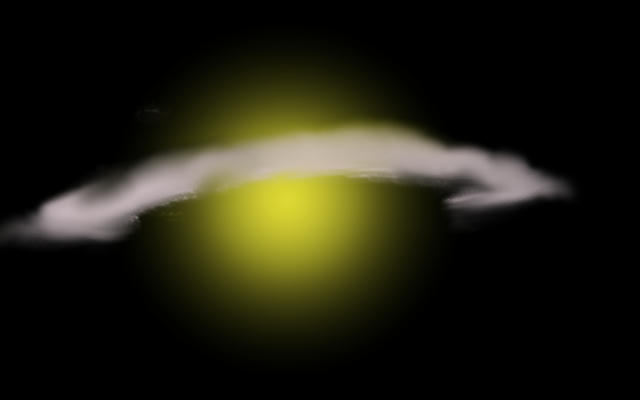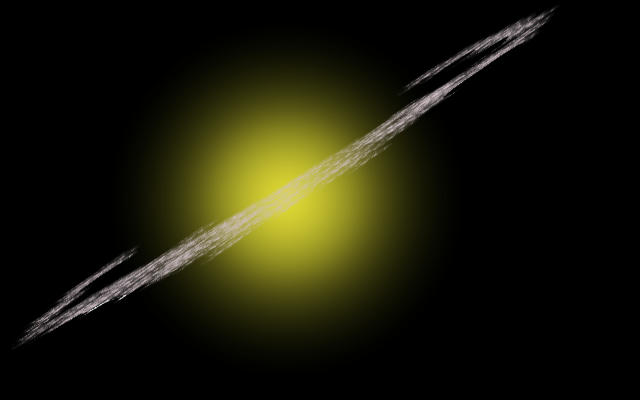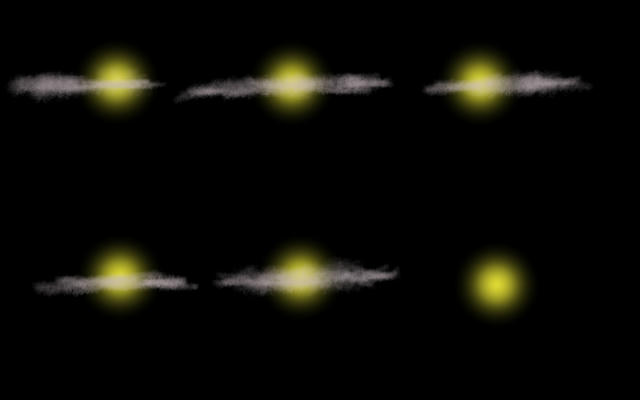Yeah, it'll be something like that. We just don't have enough data.
-
Welcome! The TrekBBS is the number one place to chat about Star Trek with like-minded fans.
If you are not already a member then please register an account and join in the discussion!
You are using an out of date browser. It may not display this or other websites correctly.
You should upgrade or use an alternative browser.
You should upgrade or use an alternative browser.
The merged and improved (?) KIC 8462852 thread
- Thread starter Dryson
- Start date
Here is an example of how rings around KIC 8462 would create a decrease in the light curve.
In the first image is a ring of debris orbiting KIC 8462. Kepler is viewing KIC 8462 from underneath of the ring. The distance from the inside diameter, closer to the sun to the outside diameter, farther away from the sun allows for more debris from the ring to block the light from KIC 8462 thus creating a decreased light curve.

In the second image Kepler is viewing KIC 8462 at a more straight on angle that reduces the the distance from the inner diameter to the outer diameter allowing more light to be seen by Kepler.
So maybe what is being seen at KIC 8462 is a ring around the sun that oscillates up and down causing more of the ring to block out the sun then over time the ring would oscillate to a position that allows more light to be seen by Kepler.

In the first image is a ring of debris orbiting KIC 8462. Kepler is viewing KIC 8462 from underneath of the ring. The distance from the inside diameter, closer to the sun to the outside diameter, farther away from the sun allows for more debris from the ring to block the light from KIC 8462 thus creating a decreased light curve.

In the second image Kepler is viewing KIC 8462 at a more straight on angle that reduces the the distance from the inner diameter to the outer diameter allowing more light to be seen by Kepler.
So maybe what is being seen at KIC 8462 is a ring around the sun that oscillates up and down causing more of the ring to block out the sun then over time the ring would oscillate to a position that allows more light to be seen by Kepler.

If it were oscillating up and down, you would see a regular variation in the time series of the light curve. That isn't what the KST observed.
Another possibility is that several large planets in conjunction could be causing the decrease in the light curve of KIC 8462.
http://www.space.com/33792-venus-jupiter-conjunction.html
The possibility of one or maybe even more than one set asteroid rich rings orbiting the KIC 8462 solar system similar to an Oort Cloud might also be possible.
http://www.space.com/33792-venus-jupiter-conjunction.html
The possibility of one or maybe even more than one set asteroid rich rings orbiting the KIC 8462 solar system similar to an Oort Cloud might also be possible.
Last edited:
Simultaneous transits by several large planets is very unlikely and would have a different dimming profile. Why don't we give it a rest until the professional astronomers have obtained more data?
Simultaneous transits by several large planets is very unlikely and would have a different dimming profile. Why don't we give it a rest until the professional astronomers have obtained more data?
That is a good suggestion in my opinion. I think that the next opportunity will be in May of 2017.
What about it? There are only three things that produce celestial bodies like that:What about large cloud of solid material might look like transiting across KIC 8462.
1) Accretion disks
2) Very large comets
3) Large clusters of smaller comets
#1 was already ruled out because it is inconsistent with the light curve data
#2 was ruled out for the same reason, because the light curve shows multiple events with reversals and not just a single object.
So #3 fits the data: multiple comets along a similar orbit producing a combined tail and coma.
Not coincidentally, such a transit would look ALOT like this:

http://www.space.com/33841-living-on-proxima-b.html
The researchers also mentioned other signals in the star's wobbles whose source was unsure — it may just be the star itself, or it might indicate another planetary neighbor, or one large planet with an entourage of smaller ones around it, the researchers said in a second press conference. That planet, though, would be farther out, larger and well away from the zone where liquid water can exist.
Perhaps there is a very large Gas Giant or Large Earth like planet with smaller moons orbiting it that caused the dimmings to take place. More so a Giant Gas Giant with Earth Like or Large Earth like planets each with their own network of rings orbiting each planet.
The researchers also mentioned other signals in the star's wobbles whose source was unsure — it may just be the star itself, or it might indicate another planetary neighbor, or one large planet with an entourage of smaller ones around it, the researchers said in a second press conference. That planet, though, would be farther out, larger and well away from the zone where liquid water can exist.
Perhaps there is a very large Gas Giant or Large Earth like planet with smaller moons orbiting it that caused the dimmings to take place. More so a Giant Gas Giant with Earth Like or Large Earth like planets each with their own network of rings orbiting each planet.
http://www.bananaplants.net/banananinfo.html
Banana is a tropical plant which grows best under warm conditions. In colder areas where banana is used mostly as an ornamental, new plants are obtained and planted each spring.
The leaves are tattered badly by strong winds, rendering the plant less attractive. Strong winds, in conjunction with saturated soil and the weight of a stem of fruit, can result in significant blow down unless guying or other protection is provided.
Perhaps there is a very large banana plant in the KIC 8462 system that has tatter leaves from a strong wind. This could be a cause for the dimming to take place.
Banana is a tropical plant which grows best under warm conditions. In colder areas where banana is used mostly as an ornamental, new plants are obtained and planted each spring.
The leaves are tattered badly by strong winds, rendering the plant less attractive. Strong winds, in conjunction with saturated soil and the weight of a stem of fruit, can result in significant blow down unless guying or other protection is provided.
Perhaps there is a very large banana plant in the KIC 8462 system that has tatter leaves from a strong wind. This could be a cause for the dimming to take place.
How many bananas though would it take to produce the dim?
I like bananas
They are even a bit radioactive:
https://en.wikipedia.org/wiki/Banana_equivalent_dose
And they're full of evil chemicals:
https://jameskennedymonash.files.wordpress.com/2014/01/ingredients-of-a-banana-poster.pdf
They are even a bit radioactive:
https://en.wikipedia.org/wiki/Banana_equivalent_dose
And they're full of evil chemicals:
https://jameskennedymonash.files.wordpress.com/2014/01/ingredients-of-a-banana-poster.pdf
This is an artists conception of what the giant space banana might look like.http://www.bananaplants.net/banananinfo.html
Banana is a tropical plant which grows best under warm conditions. In colder areas where banana is used mostly as an ornamental, new plants are obtained and planted each spring.
The leaves are tattered badly by strong winds, rendering the plant less attractive. Strong winds, in conjunction with saturated soil and the weight of a stem of fruit, can result in significant blow down unless guying or other protection is provided.
Perhaps there is a very large banana plant in the KIC 8462 system that has tatter leaves from a strong wind. This could be a cause for the dimming to take place.

A giant space banana is now the leading explanation for the dims, so we can effectively rule out comets once and for all.
Bananas are not the only fruit. Just saying...
Back to the Alien Mega Structure - http://www.mtu.edu/news/stories/201...uel-water-visible-light-highly-efficient.html
Someone posted a comment on NASA's FB page regarding the production of hydrogen from light which the process is detailed in the link above. Would it be possible that the by-products or the process itself could somehow cause the decrease in the light curve of KIC 8462852?
However, earlier this year Louisiana State University astronomer Bradley Schaefer revealed that KIC 8462852 had been slowly dimming for at least a century at a rate of 0.165 magnitudes per century – notably lower than the rate of dimming derived by Kepler. He came to this conclusion after studying historical photographic plates of the star that had been digitised as part of the Digital Access to a Sky Century at Harvard, or DASCH, project. If Schaefer is correct then not only would the century-long dimming rule out the comet fragments model, it would also suggest that a second mechanism is at working dimming the star, besides the shorter-term transits analysed by Boyajian’s team.
Not everyone agreed with Schaefer. German astrophysicist Michael Hippke and his colleagues argued that the DASCH plates were not high enough quality to make reliable measurements from, something that Schaefer vehemently denies.
However, Montet and Simon’s new research seems to lend more credence Schaefer’s results, even if it does stop short of proving Schaefer correct.
https://astronomynow.com/2016/08/08/kepler-finds-tabbys-star-is-mysteriously-dimming/
Someone posted a comment on NASA's FB page regarding the production of hydrogen from light which the process is detailed in the link above. Would it be possible that the by-products or the process itself could somehow cause the decrease in the light curve of KIC 8462852?
However, earlier this year Louisiana State University astronomer Bradley Schaefer revealed that KIC 8462852 had been slowly dimming for at least a century at a rate of 0.165 magnitudes per century – notably lower than the rate of dimming derived by Kepler. He came to this conclusion after studying historical photographic plates of the star that had been digitised as part of the Digital Access to a Sky Century at Harvard, or DASCH, project. If Schaefer is correct then not only would the century-long dimming rule out the comet fragments model, it would also suggest that a second mechanism is at working dimming the star, besides the shorter-term transits analysed by Boyajian’s team.
Not everyone agreed with Schaefer. German astrophysicist Michael Hippke and his colleagues argued that the DASCH plates were not high enough quality to make reliable measurements from, something that Schaefer vehemently denies.
However, Montet and Simon’s new research seems to lend more credence Schaefer’s results, even if it does stop short of proving Schaefer correct.
https://astronomynow.com/2016/08/08/kepler-finds-tabbys-star-is-mysteriously-dimming/
Last edited:
*pushes people back on-topic and away from ad hominem comments*
Or an alien trying to keep us distracted while the main invasion fleet gathers off Tau Ceti...Do we have any proof that @Dryson isn't a bot?
Very interesting presentation with the latest information and prospects for future observation:
Similar threads
- Replies
- 7
- Views
- 743
- Replies
- 1
- Views
- 2K
Contest: ENTER
September 2025 Art Challenge - Suggest Your Themes!
- Replies
- 4
- Views
- 8K
- Replies
- 0
- Views
- 297
Contest: ENTER
October Art Challenge - Suggest Your Themes!
- Replies
- 3
- Views
- 8K
If you are not already a member then please register an account and join in the discussion!
